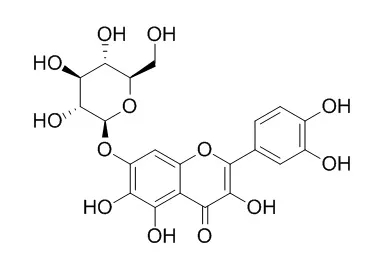| Structure Identification: |
| Nat Prod Commun. 2015 Mar;10(3):447-50. | | Anthocyanins and other flavonoids as flower pigments from eleven Centaurea species.[Pubmed: 25924526] | Anthocyanins and other flavonoids were isolated from the flowers of eleven Centaurea species, C. macrocephala, C. rupestotilis and C. suaveolens, which produce yellow flowers, and C. achtarovii, C. dealbata, C. montana, C. nigra, C. scabiosa, C. simplicicaulis, C. hypoleuca and C. triumfetti, which have cyanic flowers. Four anthocyanins, cyanidin 3,5-di-O-glucoside, cyanidin 3-O-(6"-malonylglucoside)-5-O-glucoside, cyanidin 3-O-(6"-succinylglucoside)-5- O-glucoside and cyanidin glycoside, were detected in the cyanic flowers of seven Centaurea species.
METHODS AND RESULTS:
Of these anthocyanins, the first two were found as major anthocyanins.
In the cyanic species, four other flavonoids, apigenin 7-O-glucuronide-4'-O-glucoside, malonylated apigenin 7,4'-di-O-glucoside, apigenin 7-0- glucuronide and kaempferol glycoside, were also isolated. On the other hand, nine flavonols and four flavones were isolated from the three yellow-flowered species, and identified as quercetagetin,
Quercetagetin-7-O-glucoside, quercetagetin 3'-methyl ether 7-O-glucoside, patuletin, patuletin 7-O-glucoside, quercetin 7-O-glucoside, kaempferol 3-methyl ether, kaempferol 3-methyl ether 4'-O-glucuronide and isorhamnetin 3-O-galactoside, and apigenin, apigenin 7- O-glucuronide, luteolin 7-O-glucoside and apigenin 6,8-di-C-glucoside (vicenin-2).
CONCLUSIONS:
Of these flavonoids, the former five flavonols are "yellow flavonols", and it was shown that their flower colors are due to these compounds. |
|






 Cell. 2018 Jan 11;172(1-2):249-261.e12. doi: 10.1016/j.cell.2017.12.019.IF=36.216(2019)
Cell. 2018 Jan 11;172(1-2):249-261.e12. doi: 10.1016/j.cell.2017.12.019.IF=36.216(2019) Cell Metab. 2020 Mar 3;31(3):534-548.e5. doi: 10.1016/j.cmet.2020.01.002.IF=22.415(2019)
Cell Metab. 2020 Mar 3;31(3):534-548.e5. doi: 10.1016/j.cmet.2020.01.002.IF=22.415(2019) Mol Cell. 2017 Nov 16;68(4):673-685.e6. doi: 10.1016/j.molcel.2017.10.022.IF=14.548(2019)
Mol Cell. 2017 Nov 16;68(4):673-685.e6. doi: 10.1016/j.molcel.2017.10.022.IF=14.548(2019)